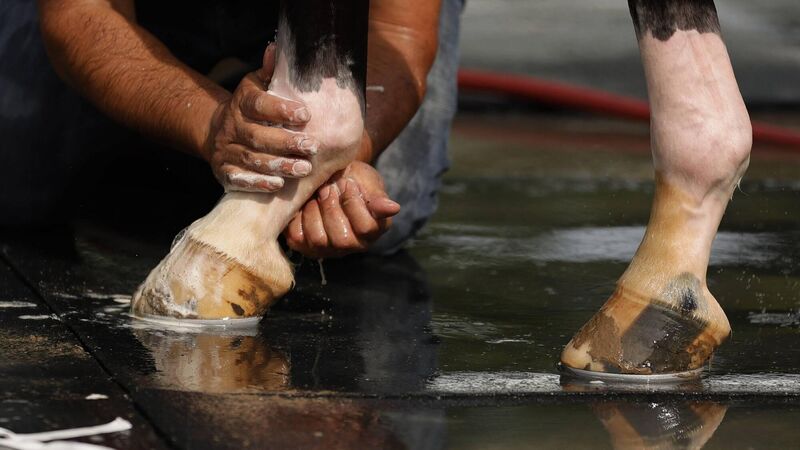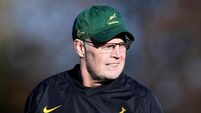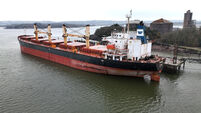Paul Rouse: 'Working in pain, hiding injuries' - inside the world of horse racing staff

Some 75% of staff said that they would seek to take time off from work in the event of sustaining a bone fracture. But just 49% of staff would take time off if they suffered a concussion.
How do you manage things when sport is your workplace?
Do you go in when you’re sick or injured?
And what happens when it is something in the workplace that actually causes you to get your injury?
A group of researchers – mostly based at the Equestrian Performance Research Centre at Hartpury University in Gloucestershire – have examined “the prevalence and the effect of injury” in British horseracing staff over the course of a year.
The results were published in a paper entitled “Is Injury an Occupational Hazard for Horseracing Staff?” in the ‘International Journal of Environmental Research and Public Health’.
A survey of some 352 staff showed that 88% reported injuries at work. The risk factors which were deemed to have led to the injuries included the working hours involved in the industry.
The core staff surveyed in this report included track riders (who had a riding-only role), racing grooms (who worked in training yards) and stud grooms (who worked in stud and breeding yards). These categories were involved in 82% of all reported accidents.
At the milder end of the scale, the injuries suffered over the 12 months before the survey was undertaken amounted to bruising and cuts or back pain. But the level of injuries amounted to fractures (at least 6%) and concussions (5.1%).
Only 3.5% of staff reported to have suffered no injuries over the previous 12 months.
What was most fascinating in the research was the response of staff working with horses to being injured.
Some 75% said that they would seek to take time off from work in the event of sustaining a bone fracture.
But just 49% of staff would take time off if they suffered a concussion.
The logic of these decisions was laid bare in the paper: “Attitudes towards injury management were influenced by financial circumstances, perceived staff shortages, previous injury experiences, and perceived employer expectations.”
There was also the significance of a working culture that was predicated on the idea of “putting the horse first”.
It is also worth noting that not reporting an injury or going to work despite being injured is also in some instances the product of a very human desire not to let colleagues down and to play a full part in the team effort that is necessary in the pursuit of sporting success.
It was interesting to note that the great majority of staff worked no more than 9 hours a day, but 13% worked at least 10 hours a day and 6% worked more than 12 hours per day.
It is clear that working through injury involved significant medication. Some 52% of respondents who answered the questions on pain management said that they took painkillers at least once a week to allow them to undertake daily work tasks.
And almost 20% took painkillers at least once a day to manager physical pain at work.
It might be noticed in passing that the use of anti-inflammatories is commonplace across the sporting world, while across the horse world 51% of dressage riders, 67% of show jumpers and 96% of event riders say they use pain relief when they are training or involved in competitions.
The impact of the level of injuries sustained by staff in horse racing and the manner in which those injuries are managed has a potentially significant impact on the horse racing industry.
As well as lowering the capacity of staff to carry out the tasks expected of them, the long term impact on individuals includes serious implications on retention and therefore on career longevity, as well as poor physical health.
The perception of invisible injuries, i.e., concussion, and subsequent management, should be of immediate concern to racing organizations.
The question for horse racing authorities and people who run various aspects of the industry is what they should do with the information on the health of their staff.
The work was undertaken by Emma Davies (in conjunction with Will McConn-Palfreyman, John K. Parker , Lorna J. Cameron and Jane M. Williams) and identifies recommendations to enhance the safety and wellbeing of horseracing staff.
It should be noted at this point that all employers have a legal obligation to ensure the health, safety, and welfare of their employees.
The paper sets out a practical step that can be taken straight away in respect of concussion: “Horseracing has previously used several major national campaigns to promote healthy behaviour in professional jockeys, such as the 2016 Jockey Matters campaign run by the Jockey Education and Training Scheme, which provided educational resources and helplines offering support on nutrition, physical fitness, injury and concussion and mental health. A national campaign to promote concussion awareness, alongside standard protocols for stud and stable staff are the next steps for the industry to tackle workplace concussion.”
There are also other recommendation, including:
The provision of an online ‘Horseracing Occupational Health & Injury Training Package’ for stud and stable staff which would set out with clarity risk factors for injury, management of equipment use during repetitive tasks (such as tools for mucking out and sweeping), and early predictors of musculoskeletal injury.
The development and subsequent implementation of a national return-to-work procedure for injured stud and stable staff.
Senior staff and managerial training on occupational injury and injury management, embedded into pre-existing courses.
In all of this, the key change is one of culture. Just as in other industries, staff who work with horses generally conform to expectations of a role that have developed over many decades. Horse racing staff are expected to manifest as “tough”. This is a manifestation that demands the suppression of pain if at all possible and the regulation of emotions perceived as weak.
This is the type of cultural norm that is understandable by people working in all manner of industries, but in this instance involves staff “acting tough, working in pain, hiding injuries, or hiding emotions for fear of losing respect or their job.” In Ireland, the basic rights of all staff that work within the racing sector are promoted by the Irish Stablestaff Association (founded 1999) who negotiate with the Irish Racehorse Trainers Association (founded 1972).
The basic rights of the stablestaff are set out in an agreement dating from 2004 (and rooted in Irish employment law) which is updated every year.
The agreement sets the minimum wage for adults working in the industry at €10.75 per hour, limits the working week to 48 hours, and sets out entitlements around sick pay and holiday pay.
Ultimately, there are more than 3,000 full-time and part-time staff employed by horse trainers across Ireland. They are a vital part of an iconic industry.
It would be fascinating to see a research project examine how injuries in Irish stablestaff compare with those in England. The lure of a job around horses for people who love them is enormous. There are also reports of labour shortages around Europe for work riders and racing grooms and other entry-level positions. This suggests a relatively high turnover of staff and conditions that are not conducive to longevity.
But the main question stands obvious: in Ireland, as in Britain, is the working culture predicated on the idea of “putting the horse first” and what does that mean for human health?








